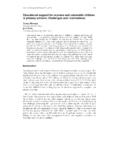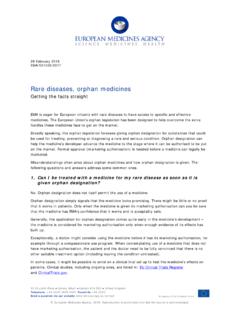Transcription of AFRICA’S ORPHANED GENERATIONS - UNICEF
1 africa S ORPHANED GENERATIONS In the past, people used tocare for the orphans andloved them, but these daysthey are so many, and manypeople have died who couldhave assisted them, andtherefore orphanhood is acommon phenomenon, notstrange. The few who arealive cannot support them. A widow in her early fifties, Kenya1 Cover photo: UNICEF /HQ96-1377/GIACOMO PIROZZIThe HIV/AIDS epidemic in sub-Saharan africa has alreadyorphaned a generation of children and now seems set toorphan GENERATIONS , over 11 million children under the age of 15 livingin sub-Saharan africa have been robbed of one or bothparents by HIV/AIDS.
2 Seven years from now, the number isexpected to have grown to 20 million. At that point, anywherefrom 15 per cent to over 25 per cent of the children in adozen sub-Saharan African countries will be orphans thevast majority of them will have been ORPHANED by s ORPHANED GENERATIONS reports on the life circum-stances of today s orphans with new data and fresh presents the possibility of change for those alreadyorphaned and for the generation to come if certain thingsare done , the number of orphans in sub-Saharan Africawill continue to rise in the years ahead.
3 Due to the highproportion of sub-Saharan African adults already livingwith HIV/AIDS and the continuing difficulties in expandingaccess to life-prolonging antiretroviral treatment. But, it isnot inevitable that these children should be left to suffertwice, denied their rights because they are s ORPHANED Generationspresents a strategy forensuring that all of africa s ORPHANED children have a safe,healthy and well-educated childhood, establishing thefoundation for a productive adult life and for their countries overall development.
4 It encourages hope in the face of anepic S ORPHANED GENERATIONSE xecutive Summary .. 4 CHAPTERSC hapter 1 The scale of the orphan crisis .. 6 Chapter 2 The impact of orphaning on families, households and communities.. 12 Chapter 3 The impact of orphaning on children .. 24 Chapter 4 Supporting africa s orphans .. 32 References .. 44 STATISTICAL TABLESG eneral note on the data .. 47 Table 1 Basic indicators .. 48 Table 2 Estimated number of orphans by country, year, type, age and cause .. 49 Table 3 Care practices.
5 50 Table 4 Impact and response .. 51 Definitions of the Indicators .. 52 FIGURESF igure 1-134 million children ORPHANED in sub-Saharan africa .. 7 Figure 1-2 The worst is yet to come: Epidemic curves, HIV/AIDS and orphans .. 8 Figure 1-3 Increase in double orphans in sub-Saharan africa due to HIV/AIDS .. 9 Figure 1-4 Select orphan projections, 2010.. 9 Figure 1-5 Distribution of orphans by rural/urban areas .. 10 Figure 1-6 Age of orphans .. 11 Figure 1-7 Percentage of children who are orphans , by urban/rural residences.
6 11 Figure 2-1 Extended families traditionally care for orphans .. 14 Figure 2-2 Impact increasingly felt by poorest households .. 16 Figure 2-3 Adults in orphan households have more dependants .. 17 Figure 2-4 Most immediate needs that households with orphans cannot meet .. 18 Figure 2-5 The burden falls on female-headed households .. 20 Figure 2-6 Women are more likely to take responsibility for orphans .. 21 Figure 2-7 Female-headed households take in more orphans than male-headed households.. 21 CONTENTSAFRICA S ORPHANED GENERATIONS5 Figure 2-8 orphans are likely to be separated from their siblings.
7 22 Figure 2-9 Older and younger family members are caring for orphans .. 22 Figure 2-10 Growing role of grandparents .. 23 Figure 2-11 Most children living on the street in Lusaka, Zambia are orphans .. 23 Figure 3-1 orphans are less likely to attend school .. 25 Figure 3-2 orphans are less likely to be at the proper education level .. 26 Figure 3-3 School is crucial to the well-being of orphans .. 29 Figure 3-4 orphans are less optimistic about their future .. 30 Figure 4-1 Communities are at the forefront of caring for vulnerable households.
8 33 Figure 4-2 Succession planning works .. 37 Figure 4-3 Disadvantage disappears under a Universal Primary Education policy .. 38 Figure 4-4 School feeding programmes keep vulnerable children in school.. 40 Figure 4-5 Many children are not registered.. 41 BOXESBox 1-1 Subnational differences .. 10 Box 2-1 Extended families and foster households .. 13 Box 2-2 The wealth index .. 16 Box 2-3 The dependency ratio.. 17 Box 2-4 Challenges to will writing in Uganda.. 19 Box 2-5 Increased burden on female-headed households.
9 21 Box 3-1 orphans and the worst forms of child labour .. 28 Box 3-2 Distress signals.. 30 Box 4-1 International commitments .. 34 Box 4-2 Guiding human rights principles .. 35 Box 4-3 Abolishing school fees: The Kenya experience .. 39 Box 4-4 Birth registration.. 41 TABLEST able 2-1 Different childcare practices for non- orphans and single orphans .. 13 Table 2-2 Dependency ratios in Uganda: Orphan households have more dependants and lower income .. 15 Among the most devastating effects of the HIV/AIDS epidemic in sub-Saharan africa is that it is orphaninggenerations of children jeopardizing their rights andwell-being, as well as compromising the overalldevelopment prospects of their 1990, fewer than 1 million sub-Saharan Africanchildren under the age of 15 had lost one or bothparents to HIV/AIDS.
10 QAt the end of 2001, 11 million in this age groupwere orphans because of HIV/AIDS, nearly 80 percent of the world 2010, 20 million in this age group are likely tobe orphans from this single cause, comprisingabout half the total number of orphans expectedin the catastrophically than elsewhere, the HIV/AIDS epidemic has deepened poverty and exacerbatedmyriad deprivations in sub-Saharan africa . Theresponsibility of caring for ORPHANED children is amajor factor in pushing many extended familiesbeyond their ability to cope.















